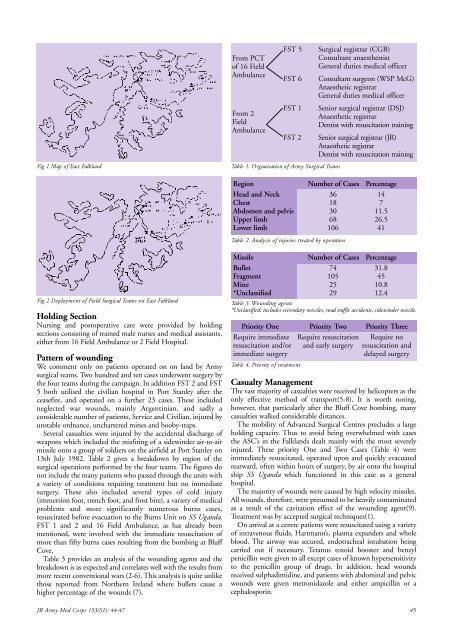Falklands war 25TH anniversarY - Boekje Pienter
Falklands war 25TH anniversarY - Boekje Pienter
Falklands war 25TH anniversarY - Boekje Pienter
You also want an ePaper? Increase the reach of your titles
YUMPU automatically turns print PDFs into web optimized ePapers that Google loves.
Fig 1 Map of East Falkland<br />
From PCT<br />
of 16 Field<br />
Ambulance<br />
From 2<br />
Field<br />
Ambulance<br />
FST 5<br />
FST 6<br />
FST 1<br />
FST 2<br />
Table 1. Organisation of Army Surgical Teams<br />
Surgical registrar (CGB)<br />
Consultant anaesthestist<br />
General duties medical officer<br />
Consultant surgeon (WSP McG)<br />
Anaesthetic registrar<br />
General duties medical officer<br />
Senior surgical registrar (DSJ)<br />
Anaesthetic registrar<br />
Dentist with resuscitation training<br />
Senior surgical registrar (JR)<br />
Anaesthetic registrar<br />
Dentist with resuscitation training<br />
Region Number of Cases Percentage<br />
Head and Neck 36 14<br />
Chest 18 7<br />
Abdomen and pelvis 30 11.5<br />
Upper limb 68 26.5<br />
Lower limb 106 41<br />
Table 2. Analysis of injuries treated by operation<br />
Fig 2 Deployment of Field Surgical Teams on East Falkland<br />
Holding Section<br />
Nursing and postoperative care were provided by holding<br />
sections consisting of trained male nurses and medical assistants,<br />
either from 16 Field Ambulance or 2 Field Hospital.<br />
Pattern of wounding<br />
We comment only on patients operated on on land by Army<br />
surgical teams. Two hundred and ten cases underwent surgery by<br />
the four teams during the campaign. In addition FST 2 and FST<br />
5 both utilised the civilian hospital in Port Stanley after the<br />
ceasefire, and operated on a further 23 cases. These included<br />
neglected <strong>war</strong> wounds, mainly Argentinian, and sadly a<br />
considerable number of patients, Service and Civilian, injured by<br />
unstable ordnance, unchartered mines and booby-traps.<br />
Several casualties were injured by the accidental discharge of<br />
weapons which included the misfiring of a sidewinder air-to-air<br />
missile onto a group of soldiers on the airfield at Port Stanley on<br />
13th July 1982. Table 2 gives a breakdown by region of the<br />
surgical operations performed by the four teams. The figures do<br />
not include the many patients who passed through the units with<br />
a variety of conditions requiring treatment but no immediate<br />
surgery. These also included several types of cold injury<br />
(immersion foot, trench foot, and frost bite), a variety of medical<br />
problems and more significantly numerous burns cases,<br />
resuscitated before evacuation to the Burns Unit on SS Uganda.<br />
FST 1 and 2 and 16 Field Ambulance, as has already been<br />
mentioned, were involved with the immediate resuscitation of<br />
more than fifty burns cases resulting from the bombing at Bluff<br />
Cove.<br />
Table 3 provides an analysis of the wounding agents and the<br />
breakdown is as expected and correlates well with the results from<br />
more recent conventional <strong>war</strong>s (2-6). This analysis is quite unlike<br />
those reported from Northern Ireland where bullets cause a<br />
higher percentage of the wounds (7).<br />
Missile Number of Cases Percentage<br />
Bullet 74 31.8<br />
Fragment 105 45<br />
Mine 25 10.8<br />
*Unclassified 29 12.4<br />
Table 3. Wounding agents<br />
*Unclassified: includes secondary missiles, road traffic accidents, sidewinder missile.<br />
Priority One Priority Two Priority Three<br />
Require immediate Require resuscitation Require no<br />
resuscitation and/or and early surgery resuscitation and<br />
immediate surgery<br />
delayed surgery<br />
Table 4. Priority of treatment<br />
Casualty Management<br />
The vast majority of casualties were received by helicopters as the<br />
only effective method of transport(5-8). It is worth noting,<br />
however, that particularly after the Bluff Cove bombing, many<br />
casualties walked considerable distances.<br />
The mobility of Advanced Surgical Centres precludes a large<br />
holding capacity. Thus to avoid being overwhelmed with cases<br />
the ASC’s in the <strong>Falklands</strong> dealt mainly with the most severely<br />
injured. These priority One and Two Cases (Table 4) were<br />
immediately resuscitated, operated upon and quickly evacuated<br />
rear<strong>war</strong>d, often within hours of surgery, by air onto the hospital<br />
ship SS Uganda which functioned in this case as a general<br />
hospital.<br />
The majority of wounds were caused by high velocity missiles.<br />
All wounds, therefore, were presumed to be heavily contaminated<br />
as a result of the cavitation effect of the wounding agent(9).<br />
Treatment was by accepted surgical techniques(1).<br />
On arrival at a centre patients were resuscitated using a variety<br />
of intravenous fluids, Hartmann’s, plasma expanders and whole<br />
blood. The airway was secured, endotracheal intubation being<br />
carried out if necessary. Tetanus toxoid booster and benzyl<br />
penicillin were given to all except cases of known hypersensitivity<br />
to the penicillin group of drugs. In addition, head wounds<br />
received sulphadimidine, and patients with abdominal and pelvic<br />
wounds were given metronidazole and either ampicillin or a<br />
cephalosporin.<br />
JR Army Med Corps 153(S1): 44-47 45

















